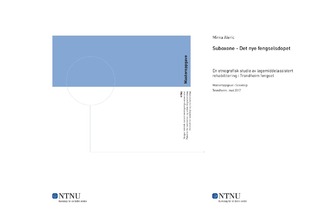Suboxone : det nye fengselsdopet : en etnografisk studie av legemiddelassistert rehabilitering i Trondheim fengsel.
Master thesis
Permanent lenke
http://hdl.handle.net/11250/2454338Utgivelsesdato
2017Metadata
Vis full innførselSamlinger
Sammendrag
Background: Opiate maintenance treatment (OMT) is being offered for rehabilitation purposes in the Norwegian society, including Norwegian prisons. The OMT program has been a controversial issue because of fear of the diversion of OMT medications and development of black markets for prescription drugs such as buprenorphine and methadone. The OTM program is seeking normalization through rehabilitation, and is therefore forced to observe their patients during the intake of buprenorphine and methadone. In this paper I’ll be focusing on the social reconstruction of OMT as a rehabilitation programme in a Norwegian prison, while trying to understand the potential of such prescription drugs in the prison context.
Methods: This paper reports on an ethnographic study of prison-based OMT programme in a closed Norwegian prison. The data includes qualitative interviews with 5 prisoners.
Results: The prison-based OMT programme was characterized by strict and repressive control to prevent the diversion of buprenorphine. My findings reveal diversion of buprenorphine in the Norwegian prison. The argument for the diversion of buprenorphine was legitimized by the excessive and repressive control, which was perceived as illegitimate and unfair by all of the patients in the OMT programme. The prisoners characterized buprenorphine as the new prison drug, and the strict control and discipline inside the prison demonstrated the collective resistance towards the perceived unfairness of the OMT programme.
Conclusion: The paper demonstrates that normalization through a control-dominated approach to prison-based OMT may have the opposite effect of what is intended.
